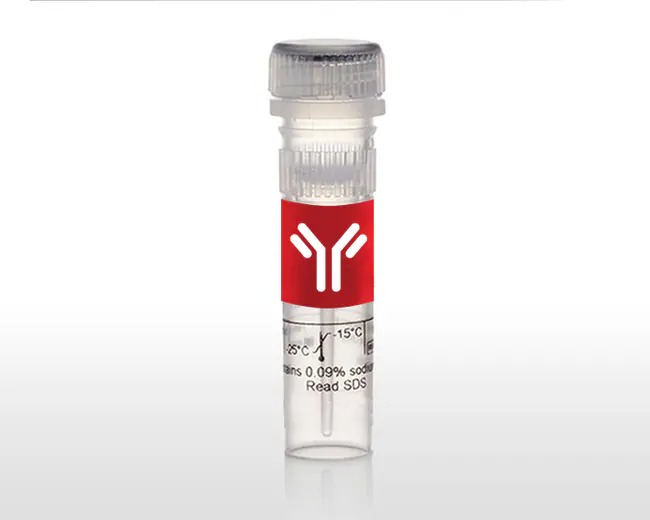Invitrogen™ HLA-ABC Monoclonal Antibody (W6/32), PE, 100 µg
Catalog No :
CAS Number :
Brand :
In Stock
Specifications:
| Application | immunocytochemistry, Flow Cytometry, Immunofluorescence | ||
| Storage Temperature | 2-8°C | ||
| Product Type | antibody | Forms | Liquid |
| Product Brand | Thermo Fisher Scientific™ | ||
| Product Grade | Molecular Biology | ||
Invitrogen™ HLA-ABC Monoclonal Antibody (W6/32), PE, is a high-specificity fluorescently labeled antibody designed for flow cytometry and immunocytochemistry applications. This antibody targets HLA-Class I (HLA-ABC) molecules, which are essential for immune system function, antigen presentation, and cytotoxic T-cell recognition.
The W6/32 clone recognizes an extracellular epitope of MHC Class I (HLA-A, HLA-B, HLA-C) molecules, making it a valuable tool for HLA typing, immune monitoring, and disease research in fields such as oncology, virology, and transplantation immunology. This antibody is conjugated to Phycoerythrin (PE), allowing direct detection in flow cytometry and fluorescence-based assays.
Key Features & Benefits
- Specific for HLA-Class I (HLA-ABC) Antigens
- Recognizes HLA-A, HLA-B, and HLA-C molecules expressed on all nucleated human cells.
- Ideal for immune profiling, transplantation studies, and antigen presentation research.
- Fluorescently Labeled for Direct Flow Cytometry Analysis
- PE-conjugated (Excitation: 565 nm, Emission: 576 nm) for high-sensitivity detection.
- Eliminates the need for secondary antibodies, reducing background noise.
- Validated for Flow Cytometry & Immunocytochemistry
- Tested for surface staining of human peripheral blood cells.
- Compatible with live and fixed cell analysis.
- Widely Used in Immunology, Cancer, and Transplantation Research
- Helps assess HLA expression levels in disease states such as cancer, viral infections, and autoimmunity.
- Used for HLA crossmatching in transplant rejection studies.
- Highly Purified & Stable Formulation
- Size-exclusion chromatography purified, ensuring high specificity and minimal background staining.
- Supplied in PBS with BSA for enhanced stability.
Product Specifications
| Feature | Details |
|---|---|
| Product Name | HLA-ABC Monoclonal Antibody (W6/32), PE |
| Catalog Number | MA1-19662 |
| Host/Isotype | Mouse / IgG2a |
| Clone | W6/32 |
| Reactivity | Human, Bovine, Cat, Non-Human Primate |
| Conjugate | Phycoerythrin (PE) |
| Excitation/Emission | 565 nm / 576 nm |
| Concentration | 0.1 mg/mL |
| Storage Buffer | PBS, pH 7.4, 0.2% BSA, 15 mM Sodium Azide |
| Purification Method | Size-Exclusion Chromatography |
| Storage Conditions | 4°C, Store in Dark, DO NOT FREEZE |
| Shipping Conditions | Ambient (Domestic), Wet Ice (International) |
| Application Methods | Flow Cytometry (1-5 µg/mL), Immunocytochemistry |
| RRID (Research Resource Identifier) | AB_1076693 |
Use Cases & Applications
1. Immunology & Transplantation Research
- HLA Typing & Crossmatching for Transplantation Studies:
- Evaluates HLA-Class I expression on donor and recipient cells.
- Helps assess graft compatibility and immune rejection risk.
- Immune Cell Profiling & Antigen Presentation Analysis:
- Used in immune monitoring of T-cell responses in infections and autoimmunity.
- Assesses HLA downregulation in tumors and viral infections.
2. Oncology & Tumor Immunology
- Characterization of HLA Expression in Cancer Cells:
- Helps identify HLA-Class I alterations in tumor microenvironments.
- Important for cancer immunotherapy research and checkpoint inhibitor studies.
- Monitoring Immune Evasion in Malignancies:
- Analyzes HLA downregulation in tumors as a mechanism of immune escape.
- Used in solid tumor and hematologic malignancy research.
3. Virology & Infectious Disease Research
- HLA Expression Changes in Viral Infections:
- Studies HLA modulation by viruses like HIV, HPV, and SARS-CoV-2.
- Investigates antigen presentation in viral immune evasion.
- Flow Cytometry-Based Detection of HLA Expression on Infected Cells:
- Allows for quantification of infected cell populations expressing MHC Class I.
- Used in research on viral latency and immune recognition.
4. Autoimmune Disorders & Neuromuscular Diseases
- HLA Expression in Autoimmune Diseases:
- Helps understand MHC Class I role in inflammatory myopathies, liver disease, and muscular dystrophy.
- Supports biomarker development for immune-mediated diseases.
- Flow Cytometry-Based Autoimmunity Profiling:
- Detects alterations in HLA-Class I in patients with autoimmune conditions.
- Aids in research on antigen presentation in autoimmune diseases.
Flow Cytometry Protocol Overview
Reagent Preparation & Sample Staining
- Prepare Cell Suspension:
- Use fresh or fixed peripheral blood mononuclear cells (PBMCs) or cell lines.
- Wash cells in FACS buffer (PBS + 2% BSA or FBS).
- Antibody Staining:
- Add 1-5 µg/mL of HLA-ABC PE-conjugated antibody to the cell suspension.
- Incubate on ice for 20-30 minutes in the dark.
- Washing & Analysis:
- Wash twice with FACS buffer to remove unbound antibodies.
- Analyze using a flow cytometer equipped with a 488 nm or 561 nm laser.
Storage & Handling Instructions
- Storage Conditions:
- Store at 4°C in the dark to preserve PE fluorescence.
- Do not freeze, as this will degrade the antibody.
- Handling Precautions:
- Use gloves and protective gear when handling reagents.
- Minimize exposure to light to prevent fluorescence loss.
- Disposal Guidelines:
- Dispose of in accordance with local laboratory waste regulations.
- Sodium azide in the buffer is toxic—handle with caution.
Why Choose Invitrogen™ HLA-ABC Monoclonal Antibody (W6/32), PE?
✅ High specificity for HLA-Class I (HLA-A, HLA-B, HLA-C) molecules
✅ PE-conjugation for direct detection in flow cytometry
✅ Validated for immunocytochemistry & HLA-expression analysis
✅ Used in transplantation, oncology, virology, and immunology research
✅ Reliable & reproducible performance for immune monitoring studies
This high-quality monoclonal antibody is an essential tool for immunology, transplantation, cancer research, and infectious disease studies, providing accurate and reproducible results in flow cytometry and cellular analysis.




 0
0
